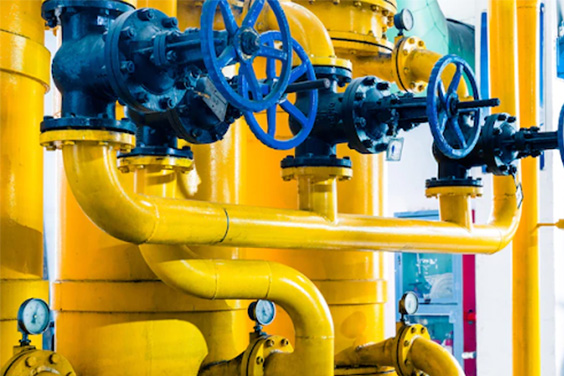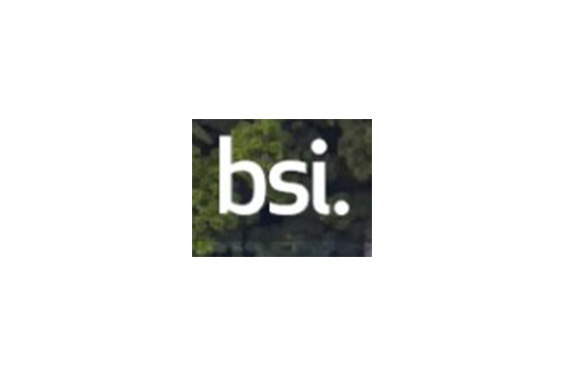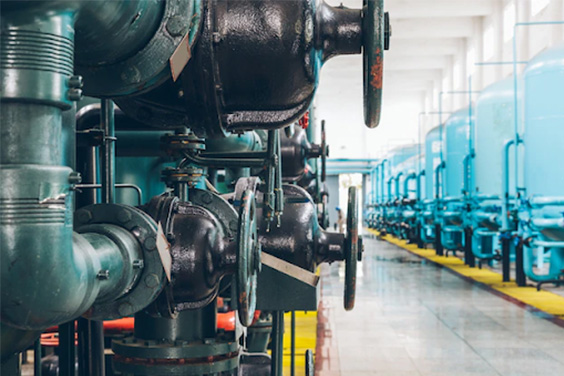
Valves are mechanical devices that are used to control the flow of liquids, gasses, and slurries within a system while also regulating pressure. In some contexts, they are also referred to as regulators, and they are utilized in a very wide range of activities. The size, design, purpose, and method of operation of valves can vary greatly.
About British Standards Institution

The British Standards Institution (BSI) is a standards-setting service provider active in many different market segments. Its standards and guidelines span a wide range of technical and managerial topics, from disaster recovery planning to quality assurance. The BSI provides assistance to businesses that are working towards European CE mark certification. European Conformity, or CE, is an abbreviation for the French phrase “Conformité Européene,” which indicates European compliance with applicable European directives (s).
In order to prove to investors that their risk management practices are up to par, companies can work with the BSI to get ISO/IEC 27001 and BS ISO/IEC 27011 certifications. These international standards are designed to aid in the implementation of information security management in telecommunications companies.
Organization for the Cooperation of Standards in Europe Products that are up to par receive the BSI Kitemark, which is a quality assurance label. Organizations can apply for the BSI Kitemark to verify that their product satisfies specific criteria, one of which is that it is secure from cybercriminals. This includes products that restrict children’s access to the internet.
Industrial Valve Standards in UK

| British Standard (Code Name BS) | British Standard Name |
| BS 1212 | Ball valves of the Portsmouth type, excluding floats and check valves |
| BS 1123 | Air receivers and compressed air installations must comply with the following specifications for safety valves, gauges, and other safety fittings: |
| BS 1414 | Specification for steel edge gate valves for the petroleum, petrochemical, and associated sectors, with flanged and butt-welding ends |
| BS 1552 | Low-pressure gas control valves are known as plug cocks. |
| BS 1570 | For use in the petroleum industry, the required specifications for flanged and butt-welded ends on steel plug valves |
| BS 1735 | Specification for flanged cast iron outside-screw-and-yoke edge gate valves of class 125 for use in the petroleum industry, ranging in size from 1.5 to 24 inches. |
| BS 1868 | Check valves made of steel, with flanged and butt-welding ends, intended for use in the petroleum, petrochemical, and allied industries. Specification. |
| BS 1873 | Specification for flanged and butt-welding ends on steel globe, globe stop, and check valves intended for use in the petroleum, petrochemical, and allied industries |
| BS 1952 | Specification for gate valves made of copper alloys to be used in general applications |
| BS 1953 | Copper alloy check valves designed for a variety of applications |
| BS 1968 | Floats for Ball valves (copper ) |
| BS 2060 | Copper alloy screw-down stop valves designed for a variety of applications |
| BS 2080 | Specification for the face-to-face, centre-to-face, end-to-end, and centre-to-end dimensions of steel valves with flanged and butt-welding ends intended for use in the petroleum, petrochemical, and allied industries |
| BS 2591 PT.1 | Part 1 of the screw-down stop, check, and gate valves section of the British standard glossary for valves and valve parts (for fluids). |
| BS 2591 PT.2 | Safety valves and pressure relief valves are both covered in this part of the British standard glossary for valves and valve parts (for fluids). |
| BS 2591PT.3 | Plug valves and cocks are discussed in part three of the British standard glossary for valves and valve parts (for fluids). |
| BS 2591PT.4 | Butterfly valves are discussed in part 4 of the British standard glossary for valves and valves (for fluids). |
| BS 2591PT.5 | Ball valves are covered in part 5 of the British standard glossary for valves and valve parts (for fluids). |
| BS 2995 | Specification for wedge gate, glove, check, and plug valves made of cast and forged steel, with screwed and socket connections; welding sizes 2 inches and smaller; intended for use in the petroleum industry |
| BS 3464 | Specification for gate valves made of cast iron to be used for general applications |
| BS 3808 | Specification for flanged, screwed, and socketed cast and forged steel components that are welded In the petroleum industry, wedge gate valves with a compact design are used for sizes smaller than 2 inches. |
| BS 3948 | Specification for parallel slide valves made of cast iron intended for use in broad contexts |
| BS 3952 | Specification for butterfly valves made of cast iron to be used in general applications |
| BS 3961 | Specification for cast iron screw-down stop valves, stop and check valves, and check valves to be used for general applications |
| BS 4090 | Cast-iron check valves suitable for a variety of applications |
| BS 4133 | Flanged steel parallel sliding valves for general uses |
| BS 4312 | For a variety of applications, flanged steel screw-down stop valves, as well as stop and check valves, are available. |
| BS 4460 | Ball valves made of steel for use in the petroleum industry |
| BS 5146 | The petroleum, petrochemical, and allied industries’ specification for the inspection and testing of steel valves |
| BS 5150 | Wedge and double disc gate valves made of cast iron, intended for general applications |
| BS 5151 | Cast iron gate (parallel slide) valves for general purposes |
| BS 5152 | Valves made of cast iron, including globe and globe stop and check valves, used for general applications |
| BS 5153 | Cast-iron check valves suitable for a variety of applications |
| BS 5154 | Globe stop and check, check, and gate valves made of copper alloy, designed for general applications |
| BS 5155 | Butterfly valves made of cast iron and carbon steel that are used for general purposes |
| BS 5156 | General-purpose screw-down diaphragm valves for a variety of applications |
| BS 5157 | Steel gate (parallel slide) valves for general purposes |
| BS 5159 | Specification for ball valves made of cast iron and carbon steel that are intended for general applications |
| BS 5160 | Specification for globe valves made of flanged steel, globe stop and check valves, and lift type check valves to be used for general applications |
| BS 5351 | Ball valves made of steel that are used in the oil and gas, petrochemical, and other related sectors |
| BS 5417 | Examination of industrial valves designed for general use |
| BS 5418 | Industrial valves with a general use that are marked |
| BS 61 | Threading requirements for light gauge copper tubes and fittings (specification) |
| BS 65 | Specifications for vitrified clay pipes, fittings, and ducts, as well as flexible mechanical joints, all intended exclusively for use with surface water pipes and fittings |
| BS 78-2 | Cast iron spigot and socket pipes that are vertically cast, as well as spigot and socket fittings, are subject to the following specifications: |
| BS 416-1 | Specification for spigot and socket systems involving sand-cast or spun cast-iron discharge and ventilating pipes and fittings |
| BS 437 | Detailed description of spigot and socket drain pipes and fittings made of cast iron |
| BS 567 | Light quality requirements for asbestos-cement flue pipes and fittings, as well as any other specifications |
| BS 835 | Heavy quality requirements for the use of asbestos-cement flue pipes and fittings |
| BS 1113 | Detailed requirements for the design and construction of a water-tube steam generating facility (including superheaters, reheaters and steel tube economizers) |
| BS 1127-2 | Dienuts and screwing dies – Specification for circular hand- and machine-operated screwing dies for taper pipe threads |
| BS 1127-3 | Screwing dies and dienuts – Specification for circular hand- and machine-operated screwing dies for parallel pipe threads Screwing dies and dienuts |
| BS 1471 | For the purposes of general engineering, the specification for wrought aluminium and aluminium alloys includes drawn tube. |
| BS 1600 | Specifications for the lengths and diameters of steel pipes used in the oil and gas industry |
| BS 1640-1 | Wrought carbon and ferritic alloy steel fittings are the ones that meet the requirements of the specification for steel butt-welding pipe fittings used in the petroleum sector. |
| BS 1640-2 | Wrought and cast austenitic chromium-nickel steel fittings are required to comply with this specification for steel butt-welding pipe fittings used in the petroleum industry. |
| BS 1640-3 | Wrought carbon and ferritic alloy steel fittings are the ones that meet the requirements of the specification for steel butt-welding pipe fittings used in the petroleum sector. |
| BS 2494 | Detailed description of elastomeric seals for use in pipe joints and pipelines |
| BS 3074 | A specification for a seamless tube made of nickel and nickel alloys |
| BS EN 1229 | Plastics piping systems – Glass-reinforced thermosetting plastics (GRP) pipes and fittings – Test methods to prove the leaktightness of the wall under short-term internal pressure Plastics piping systems – Glass-reinforced thermosetting plastics (GRP) pipes and fittings Plastics piping systems – Test methods to prove |
| BS EN 1277 | Thermoplastics piping systems for buried non-pressure applications Plastics piping systems Test methods for the leaktightness of elastomeric sealing ring type joints |
| BS EN 1056 | Systems for plastic piping and ducting – Methods for exposing plastics pipes and fittings to direct (natural) weathering plastics piping and ducting systems Plastic pipes and fittings |
| BS EN 969 | Specification for pipes, fittings, accessories, and their joints made of ductile iron for use in gas pipelines – Requirements and test methods |
| BS EN 922 | Plastics piping and ducting systems – Specimen preparation for determining the viscosity number and calculating the k-value of unplasticized poly(vinyl chloride) (PVC-U) pipes and fittings Plastics piping and ducting systems – Pipes and fittings of unplasticized poly(vinyl chloride) (PVC-U) k-value |
| BS EN 1120 | Plastics piping systems – Glass-reinforced thermosetting plastics (GRP) pipes and fittings – Determination of the resistance to chemical attack from the inside of a section in a deflected condition Plastics piping systems – Glass-reinforced thermosetting plastics (GRP) pipes and fittings Plastics piping systems – Determination of the resistance to |
| BS 6464 | Specification for pipes, fittings, and joints made of reinforced polymers for use in process plants |
| BS 7159 | A code of practise for the design and construction of piping systems made of glass-reinforced polymers for individual factories or sites |
| BS 7291-1 | Pipes made of thermoplastics and the associated fittings that are used to transport hot and cold water for use in the home as well as for heating installations in buildings |
| BS 7291-2 | Pipes made of thermoplastics and the associated fittings that are used to transport hot and cold water for use in the home as well as for heating installations in buildings – Specification for polybutylene pipes and the fittings that go with them |
| BS 7336 | Specification for polyethylene fusion fittings with integral heating elements for use with polyethylene pipes for the transportation of gaseous fuels; these fittings are intended to be used with polyethylene pipes. |
| BS 7677 | Recommendations for the categorization of flaws found in pipe joint rings |
| BS 7838 | Specification for corrugated stainless steel semi-rigid pipe and accompanying fittings for use in low-pressure gas pipework with a maximum pipe diameter of 28 millimetres |
| BS 7892 | The specifications for the application of seal coats on cement mortar lined ductile iron pipes and fittings |
| BS 8010-2.5 | Pipeline code of practice: design, construction, and installation of land-based pipelines using glass-reinforced thermosetting plastics |
| BS EN 253 | District heating pipes are preinsulated bonded pipe systems for directly buried hot water networks. They consist of a pipe assembly made out of steel service pipe, polyurethane thermal insulation, and an outer casing made out of polyethene. |
| BS EN 448 | Fittings assemblies of steel service pipes, polyurethane thermal insulation, and outer casings of polyethylene are the components that makeup district heating pipes, which are preinsulated bonded pipe systems for directly buried hot water networks. |
| BS EN 476 | General specifications for the components that are utilised in gravity drainage systems’ discharge pipes, drains, and sewers |
| BS EN 489 | Joint assembly for steel service pipes, polyurethane thermal insulation, and outer casing of polyethylene district heating pipes Preinsulated bonded pipe systems for directly buried hot water networks District heating pipes |
| BS EN 545 | Pipes made of ductile iron, their fittings and accessories, and the joints between them used for water pipelines – Requirements and test methods |
| BS EN 588-1 | Pipes made of fibre cement for use in gravity drainage systems, including sewers and drains; fibre cement joints and fittings |
| BS EN 598 | Pipes, fittings, accessories, and joints made of ductile iron that are used in sewage treatment facilities – Requirements and test methods |
| BS EN 639 | Common demands placed on concrete pressure pipes, including those pertaining to joints and fittings |
| BS EN 640 | Pipes made of reinforced concrete under pressure and pipes made of distributed reinforcement concrete under pressure (of a type that is not a cylinder), along with their joints and fittings |
| BS EN 641 | Pressure pipes made of reinforced concrete, of the cylinder type, along with their joints and fittings |
| BS EN 642 | Prestressed concrete pressure pipes, cylinder and non-cylinder, including joints, fittings, and particular requirement for prestressing steel for pipes and concrete pressure pipes, cylinder and non-cylinder |
| BS EN 723 | Combustion method for determining the amount of carbon present on the interior surface of copper tubes or fittings, applicable to copper and copper alloys |
| BS EN 911 | Mechanical joints and elastomeric sealing rings for thermoplastic pressure piping systems |
| BS EN 922 | Plastics piping and ducting systems – Specimen preparation for determining the viscosity number and calculating the k-value of unplasticized poly(vinyl chloride) (PVC-U) pipes and fittings Plastics piping and ducting systems – Pipes and fittings of unplasticized poly(vinyl chloride) k-value |
| BS EN 969 | Specification for pipes, fittings, accessories, and their joints made of ductile iron for use in gas pipelines – Requirements and test methods |
| BS EN 1056 | Plastics piping and ducting systems – Plastics pipes and fittings – Method for exposure to direct (natural) weathering |
| BS EN 1119 | Joints for glass-reinforced thermosetting plastics (GRP) pipes and fittings; methods for determining the leak tightness and damage resistance of flexible and reduced-articulation joints in plastics piping systems |
| BS EN 1120 | GRP (Glass-reinforced thermosetting plastics) piping and fittings are a type of plastic piping used in plumbing systems. Resistance to chemical attack when viewed from the inside of a deflected section |
| BS EN ISO 8497 | Circular pipe thermal insulation: calculating steady-state thermal transmission properties |
| BS 3L 63 | Description of the parameters for an aluminium-copper-magnesium-silicon-manganese alloy tube |
| BS L 105 | Specification for a tube made of aluminium-copper-magnesium-silicon-manganese alloy (aged at room temperature after undergoing solution treatment). |
| BS L 114 | Specification for a tube made of an aluminium-magnesium-silicon-manganese alloy that has been treated in both solution and precipitation and has a wall thickness that does not exceed 10 millimeters. |
| BS 2L 116 | Specification for a tube made of aluminium with 99% purity (cold drawn, seamless, and not tested hydraulically). |
| BS L 117 | The specification for a tube made of an aluminium-magnesium-silicon-copper-chromium alloy (solution treated and artificially aged; not tested hydraulically) (not exceeding 10 mm thickness) |
| BS L 118 | Specification for tube of aluminium-magnesium-silicon-copper-chromium alloy (solution treated and artificially aged: tested hydraulically) (not exceeding 10 mm thickness) |
Conclusion
There are a number of different approaches that can be used to categorize valves, such as the control mechanism and the function of the industrial valve. Valves have a wide variety of applications across the commercial, residential, and industrial sectors of the economy. Because of the diverse applications, there are many important regulatory organizations that develop standards to ensure that users have access to products that are safe, properly functional, and compatible with their needs.









